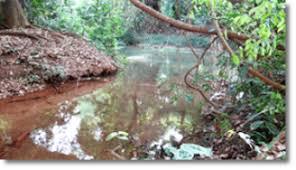Forêt classée de Kou

Cette forêt classée est gérée par le projet BKF et l’Office National du Tourisme depuis 2006. Classée en 1951, cette forêt de 115 ha est un des rares exemples restant d’une forêt de type guinéen au Burkina Faso. Sa réserve écologique (flore et faune) en fait un exemple unique dans un pays sahélien.
La région de Bobo Dioulasso compte d’autres forêts : la forêt classée du Kua, la forêt classée de Kuinima et la forêt classée de Dindéresso, mais aucune n’égale la forêt de Kou.
Cette forêt est irriguée par de nombreuses sources qui alimentent la ville de Bobo Dioulasso en eau potable. Elle est traversée par la rivière Kou, un des principaux affluents du Mouhoun. Le Kou irrigue la riziculture placée en aval de la forêt. Elle est également traversée par la rivière Guinguette qui se jette dans le Kou. Le secteur est surnommé « guinguette » à cause d’une piscine naturelle en bordure de la forêt, piscine très fréquentée par les touristes et les Bobolais.
La bonne conservation de la forêt s’explique par la coutume : ce lieu est en effet sacré pour les villageois alentours. La pression touristique a forcé les autorités – aidées en cela par un partenariat avec le Grand Duché du Luxembourg – à renforcer la protection de la forêt, notamment en développant des infrastructures extérieures à la forêt afin de conserver celle-ci uniquement pour des balades guidées et en construisant un mur de protection tout autour des 115 ha.
La forêt emploie toute une équipe : pour l’accueil mais également des forestiers et 10 guides de la forêt, travaillant par roulement de 5 dans une journée.
La forêt de Kou se partage en trois zones végétales :
- La forêt claire
- La forêt arbusive
- La forêt dense
Plusieurs arbres sont aisément identifiables grâce à des panneaux de bois ethnobotaniques plantés à leur pied. Des allées sont dégagées et régulièrement nettoyées afin de parcourir la forêt, organisées en quatre sentiers thématiques afin de favoriser l’écotourisme. Des aires de repos sont aménagées avec des bancs et des corbeilles servant de poubelles, les rivières se traversent à l’aide de deux ponts suspendus.
La végétation aquatique se rencontre sur les bords des deux rivières : Kou et Guinguette. On y rencontre des lotus.
Les forêts galeries se rencontrent autour du Kou et de la Guinguette, formant une véritable ceinture végétale très dense avec de très grands arbres pouvant atteindre 30 mètres. Certaines zones sont presque impénétrables. Le feuillage est tellement dense qu’on aperçoit à peine le ciel. Cette végétation humide favorise le développement d’un flore mycologique qui pousse sur le bois mort ou les feuilles en décomposition.
Les forêts claires sont en lisière. C’est la partie la plus importante de la forêt. Les canopées sont moins denses et laissent passer la lumière. Cette partie comporte entre autre une zone de plantation de teck, exploité par la FCK.
Les savanes arborées et boisées sont beaucoup plus espacées et la végétation au sol présente un tapis herbeux formé essentiellement de graminées.
La forêt de Kou présente également un grand intérêt au niveau de la faune : de nombreux animaux vivent en liberté, parmi eux des crocodiles, des serpents de plusieurs espèces (dont des pythons), des agoutis, lièvres et autres petits mammifères. Les rivières abritent des poissons qu’il est interdit de pêcher.
La forêt de Kou est surtout connue pour ses oiseaux : pas moins de 164 espèces y ont été recensées : oiseaux d’eau et oiseaux terrestres.
Infos pratiques
Accès en voiture jusqu’à l’entrée de la forêt par une route bitumée. Parking devant la forêt. Entrée : 1000 francs Téléphone : 60 72 67 54

 Burkina Faso : Pays des Hommes intègres
Burkina Faso : Pays des Hommes intègres  Office National du Tourisme Burkinabè
Office National du Tourisme Burkinabè